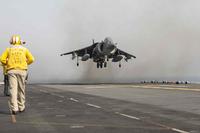At Shaw Air Force Base in sunny Sumter, S.C., the pilots and maintainers of the 77th Fighter Squadron "Gamblers" are putting a new twist on an old mission, training to kill air defenses with the latest American version of the ubiquitous F-16 Viper.
The Gamblers fly around 20 1990s-vintage F-16CJ Block 50s, the model of the Viper optimized for Suppression of Enemy Air Defenses, or SEAD. They're radar killers, Wild Weasels, descendents of the F-105s and F-4s that fistfought SAMs over Vietnam and the Gulf. When the small force of highly-specialized two-seat F-4G Wild Weasels was retired in 1996 and single-seat F-16CJs procured to take over the job, critics said it was a step back for SEAD.
And they were right -- for a while. In its early days, the F-16CJ was limited to getting azimuth-only targeting data on enemy radars using its Harm Targeting System (HTS) pod. Without the ability to determine range, HTS-equipped Wild Weasels could only lob a HARM missile in the general direction of the bad guy's radar and hope for the best.
That was then. Almost a decade after it inherited the Wild Weasel mission, the F-16CJ is finally getting the tools it needs to equal and surpass the F-4G as a SEAD platform. These tools -- the Link-16 datalink, the Joint Helmet-Mounted Cueing System (JHMCS), color displays and a major software upgrade -- are being added to all 650 or so F-16C Block 40/42/50/52s under the $1-billion Common Capability Implimentation Program (CCIP). Paired with GPS and HTS, CCIP enables F-16CJs to share a bewildering variety of data with a wide range of platforms including other fighters, AWACS, J-STARS, Rivet Joint recce planes, Aegis cruisers, Patriot missile batteries and more.  The key to this data-sharing is the Link-16's encryptable, frequency-hopping, high-volume waveform. Basically, Link-16 is an internet in the sky, and it's revolutionizing the way jet fighters wage war.
The key to this data-sharing is the Link-16's encryptable, frequency-hopping, high-volume waveform. Basically, Link-16 is an internet in the sky, and it's revolutionizing the way jet fighters wage war.
The new ability to combine off-board data with their own means the Wild Weasels can now pinpoint the locations of radars, track them with their helmet sights, shoot HARMs accurately and even drop JDAMs -- a new level of destructive capability that has necessitated some new terminology: Destruction of Enemy Air Defenses, or DEAD.
When CCIP wraps in around five years, the USAF will have 650 modern and flexible fighters capable of a full range of missions, from air defense to close air support to SEAD/DEAD. While the fighters are capable of swinging roles, the pilots will continue specializing, meaning the Gamblers will keep focusing on SEAD even though their jets can do much more.
With several hundred older F-16s slated for retirement in the next couple of years, some observers are worried that the Air Force will be stretched thin. The Air Force counters that the remaining fighters will more than make up for the cuts with greatly improved capability. While cuts can go only so far (you still need a four-ship flight to get anything accomplished, regardless of the individual jets' strengths), every indication is that the Air Force is performing a minor miracle, steadily increasing combat capability with a smaller and smaller fleet of airplanes. Research into new waveforms promises even more miracles.
--David Axe
Riding the Wave(form)
© Copyright 2024 Military.com. All rights reserved. This article may not be republished, rebroadcast, rewritten or otherwise distributed without written permission. To reprint or license this article or any content from Military.com, please submit your request here.








